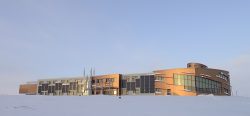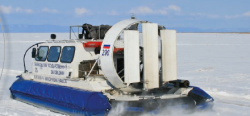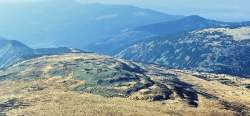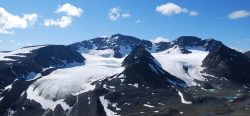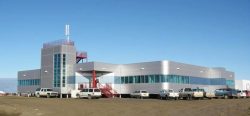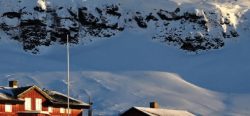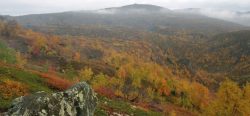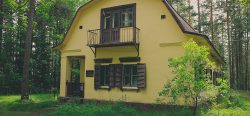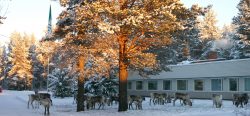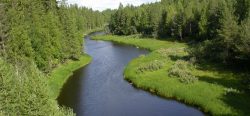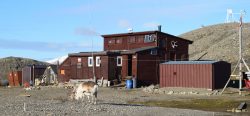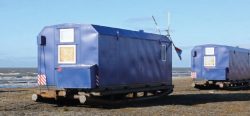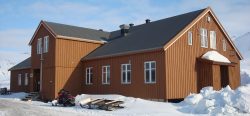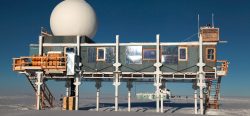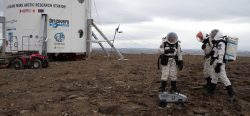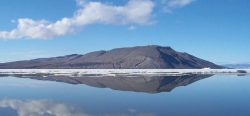Collaborator in the project until spring 2022
STATION NAME AND OWNER
Willem Barentsz Biological Station is presently owned by the Administration of Taimyr Reserves, Norilsk, Russia (governmental organization of the Russian Federation).
LOCATION
Willem Barentsz Biological Station is located in the western part of the Taimyr Peninsula, northeast of Meduza Bay (the northern end of the mouth of the Yenisey River), 18 km south of Dikson (73°21’ N, 80°32’ E) and lies next to a protected area managed by the Administration of Taimyr Reserves.
BIODIVERSITY AND NATURAL ENVIRONMENT
The area lies in the arcticDefinitions of the Arctic vary according to environmental, geographical, political, cultural and scientific perspectives. Some scientists define the Arctic as areas having a high latitude, long winters, short, cool summers,... More tundraA type of ecosystem in which tree growth is limited by low temperatures. The origin of the word is from from the Kildin Sami word t?ndâr, meaning "uplands" or "treeless mountain tract". In the northern... More belt and is characterized by a rolling relief with rocky outcrops raising above the tundraA type of ecosystem in which tree growth is limited by low temperatures. The origin of the word is from from the Kildin Sami word t?ndâr, meaning "uplands" or "treeless mountain tract". In the northern... More surface. River banks and beaches are dominated by exposed gravel/sand deposits. The altitude of the area is 0 – 40 m a.s.l. The terrain is snow-covered from September to June, small rivers run in depressions between the hills, but are usually dried up by the end of summer. There are no lakes, but some depressions are occupied by polygonal bogs. PermafrostPermafrost is frozen ground that remains at or below zero degrees Celsius (32 degrees Fahrenheit) for two or more years. It forms in regions where the mean annual temperature is... More is continuous. Vegetation is dominated by arcticDefinitions of the Arctic vary according to environmental, geographical, political, cultural and scientific perspectives. Some scientists define the Arctic as areas having a high latitude, long winters, short, cool summers,... More tundraA type of ecosystem in which tree growth is limited by low temperatures. The origin of the word is from from the Kildin Sami word t?ndâr, meaning "uplands" or "treeless mountain tract". In the northern... More lichens, mosses, sedges, grasses, dwarf willows, and birches. More than 10 shorebird species, six waterfowl species (including the red-breasted goose), and about 10 passerine species nest in the area. Avian and terrestrial predators are represented by the snowy owl, rough-legged buzzard, peregrine falcon, three species of skuas, and arcticDefinitions of the Arctic vary according to environmental, geographical, political, cultural and scientific perspectives. Some scientists define the Arctic as areas having a high latitude, long winters, short, cool summers,... More fox, lemmings being their basic prey. A few records of muskox and polar bear are known.
HISTORY AND FACILITIES
The idea of the establishment of Willem Barentsz Biological Station for the memory of the famous ArcticDefinitions of the Arctic vary according to environmental, geographical, political, cultural and scientific perspectives. Some scientists define the Arctic as areas having a high latitude, long winters, short, cool summers,... More explorer was suggested and initiated by Prof. Evgeny Syroechkovskiy during work of the ArcticDefinitions of the Arctic vary according to environmental, geographical, political, cultural and scientific perspectives. Some scientists define the Arctic as areas having a high latitude, long winters, short, cool summers,... More Expedition of the Russian Academy of Sciences (RAS) in Taimyr. The building was erected in 1995 with financial support from the Dutch Ministry of Agriculture, Nature Management, and Fisheries. Monitoring and research work was initiated in1994 by RAS and since then carried out mainly as cooperation between various Russian and European researchers. The station consists of a large building with bedrooms, a storage room, a kitchen, a toilet, and a few small sheds, which can house up to 15 people. A diesel driven generator and solar power is used for energy supply, and portable diesel or kerosene stoves for heating and cooking.
GENERAL RESEARCH AND DATABASES
The station provides unique opportunities for complex monitoring studies aimed at assessment of the long-term dynamics of local numbers of arctic-breeding birds and their nesting success, studies of prey-predator interactions and many other aspects of population biologyThe study of life and living organisms (from the Greek word 'bios' meaning life).... More. Since 1998, a standardised monitoring program for breeding bird, lemming, and predator abundance, as well as nesting success in water birds has been conducted at permanent 4 km2 and 12 km2 sample plots near the station. The long-term studies carried out at the station encompass many aspects of breeding biologyThe study of life and living organisms (from the Greek word 'bios' meaning life).... More of birds, such as arrival and departure dates, breeding phenologyThe study of the timing of recurring natural events such as bud opening, egg laying or the arrival of a migratory animal. Many living organisms have defined life cycle events... More, incubation schedules, variation of body condition during incubation, energy requirements and expenditure of chicks and adults, and nesting success. A number of biotic and abiotic factors, including arthropod abundance are also monitored and the vegetation of the areas mapped. Information on the peculiarities and conditions of breeding seasons, and the abundance of birds, lemmings, and predators can be
found in the ArcticDefinitions of the Arctic vary according to environmental, geographical, political, cultural and scientific perspectives. Some scientists define the Arctic as areas having a high latitude, long winters, short, cool summers,... More Bird Database maintained in the framework of the International Breeding Conditions Survey on ArcticDefinitions of the Arctic vary according to environmental, geographical, political, cultural and scientific perspectives. Some scientists define the Arctic as areas having a high latitude, long winters, short, cool summers,... More Birds (www.arcticbirds.net).
HUMAN DIMENSION
Dikson, an urban-type settlement in Taimyrskiy Dolgano-Nenetskiy District of Krasnoyarsk Kray is the nearest human settlement. The district (218 959 km2) is one of the least densely populated areas of Russia (0.003 persons per 1 km2) and one of the most isolated settlements in the world (2507 km from Krasnoyarsk and 506 km from Dudinka). Dikson still exercises economical functions of federal importance as it houses a state border post, a hydrographic base, and a weather station. There are no indigenousBelonging to a certain place. Indigenous people are distinct ethnic groups that have historic connections to people who lived in a territory prior to the area being colonized or coming... More people in Dikson and human impact on environment is minimal.
ACCESS
The station is accessible from Dikson year-around by vezdekhod (caterpillar vehicle), other all-terrain vehicles, or boat when ice melts in July. There are regular flights from Norilsk to Dikson (526 km) and from Norilsk to 15 Russian cities, including Moscow and Saint-Petersburg.

